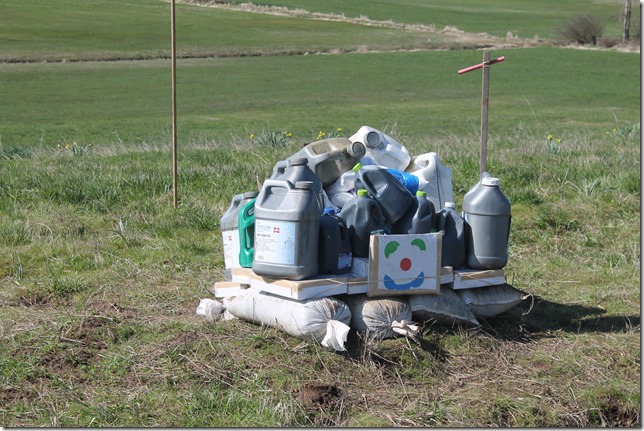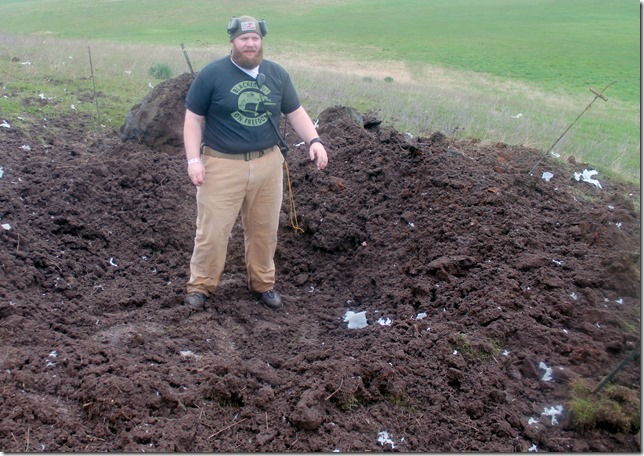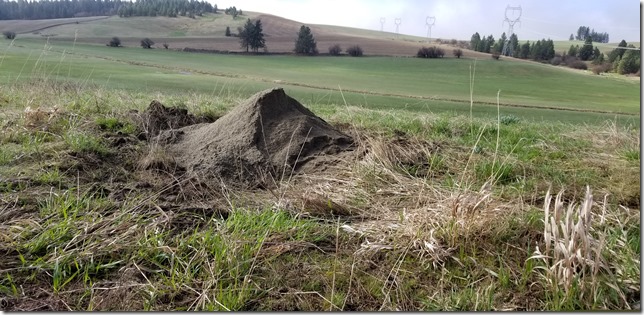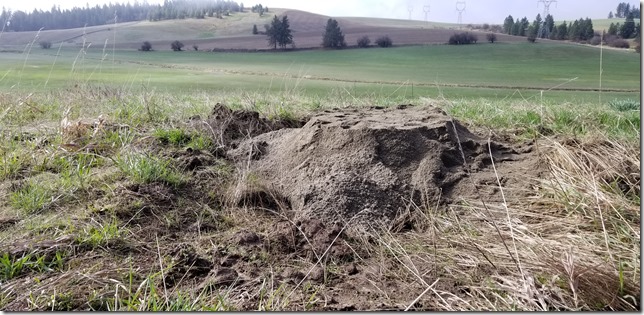Each year at Boomershoot we start the long range event on Sunday with a fireball target:
Notice all the dirt coming back at the audience?
This means there is a crater:
There used to be a house and other buildings at this location. Sometimes we find metal objects in the dirt. If some of these metal objects landed on people or their property the damage would be a very bad thing.
There is also the problem that with the increasing number of craters we don’t have a good place to put the fireball. It needs to be slightly elevated so the explosives, at the bottom of the fireball target can be shot from a safe distance.
Last year we used some sand bags to raise it above the ground some:
 That helped make it easy to shoot but it didn’t eliminate the crater problem.
That helped make it easy to shoot but it didn’t eliminate the crater problem.
Last weekend I bought some sand* and filled in last year’s crater. I made a small platform on top of the sand for the placement of the fireball target:
Next Sunday we will know how this works.
* This was Ry’s idea.





Can Not Wait!
We were just talking about the fireballs tonight. Getting more excited by the day!
I expect the original crater to get deeper. The sand will absorb some of the energy, but not enough. Eventually, the replacement sand will get deep enough, and the ground far enough away from the shockwave, to eliminate any more earth removal. Wet sand will act differently from dry. More explosive force will extend the cratering.
My expectation is that the because the sand has more mass than the dirt which was originally there that some of the sand will remain and the crater will be slightly smaller than the previous crater.
In less than a week we will find out which, if any, hypothesis is correct.
Fertilizer is already part of the “mix”. Unfortunately for your plan the fertilizer detonates and releases excess oxygen. This would turn the seeds into “fuel”. Even without the excess fertilizer the fireball would incinerate the seeds. It is very hot.
Nice idea, but there was a reason relatively inert components were chosen. Even the plastic from the sand bags falls from the sky in flames. I have speculated, but mostly dismissed, that even some of the sand may turn into molten glass and fall from the sky.
What about putting a couple of pallets on top of that earth pile, and then using the original sandbag assembly on top of that?
My reasoning – which may be faulty! – is that in the original arrangement, you already have the explosives “reverse-tamped”, i.e. a heavy mass underneath, so most of the blast gets used on air. However, the sandbags are coupled directly to the earth, so in effect, the pile of explosives are basically siting directly on the earth.
Now, if you support that assembly above the dirt pile, the explosion would have to accelerate the sand mass, crush the pallets and only THEN impact the pedestal below. Since the top and sides are open to the air, most of the blast should take the path of least resistance rather than “trying” to accelerate the sandbags.
I use pallets in the example because you can frequently get them cheap or free, but I suspect anything that would insert distance and be relatively fragile would work.
From the standpoint of preventing craters that would work. But, preventing craters is WAY down on the list of priorities.
Number one is safety. One year we used sandbags to sort of recreate a crater above ground. dozens of wooden stakes were leaned up against the sandbags on the rear of the preformed “crater” to direct the blast upward and give more lift to the gasoline. What could go wrong?
Answer: We had flaming stakes falling from the sky.
Any solid objects in the vicinity of the explosives is a potential projectile. The grains of sand have a low enough ballistic coefficient they will not cause any damage if they reach the audience, which is unlikely unless the wind is blowing toward them, in which case it’s no more than dust in the wind. A wood pallet? NNNNNOOOOOO!!!!!!
Number two is that we want the path of least resistance to be the gasoline on top of the explosives. The entire point of the explosives is to lift the 30+ gallons of gasoline and mix it with the air. Letting the explosives “vent” to the bottom is counter productive.